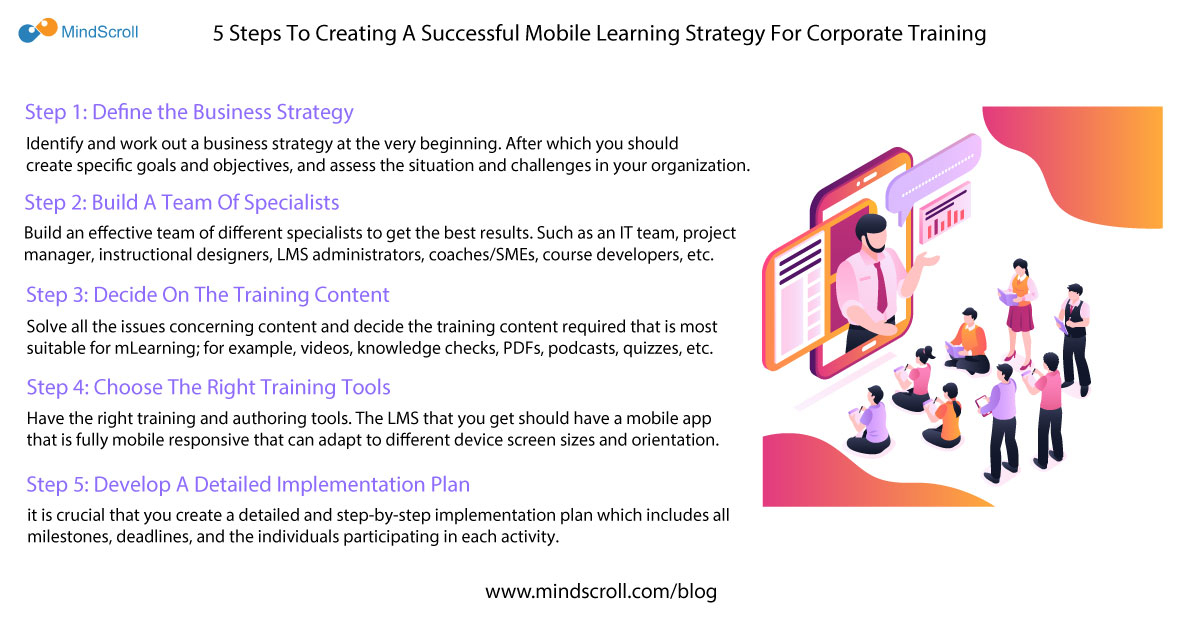Today mobile learning is a must-have strategy for the new corporate learning environment due to the large number of employees working remotely. In this new workplace dynamics it is important that the training caters to specific needs of remote learners.
Many organizations already provide mobile learning and the trend is growing. According to the LinkedIn 2019 Workplace Learning Report, 74% of employees have said that they access resources from their mobile devices to do their jobs. Moreover, when leveraged the right way, mobile learning can increase learner engagement and motivation, meet both learner and business expectations, enable learners to take the training seamlessly across devices, facilitate the application of acquired learning on the job, foster a culture of continuous learning, and more.
However it can be sometimes difficult to plan an effective mobile training strategy especially in the case where it was not done earlier at your company. That is where this article will come useful to you in successfully deploying mobile learning in your organization. Follow these steps below to create a successful mobile learning strategy for your corporate training program and improve your organization’s training strategy and effectiveness:
Step 1: Define the Business Strategy
It is very essential that you identify and work out a business strategy at the very beginning. After which you should create specific goals and objectives, and assess the situation and challenges in your organization. Then describe what business issues are present, which issues training can solve, and how they affect your organization’s results. Also ask you team questions like what business issues does the training have to resolve.
Another important thing to consider is how your learners will access training content. Training will have to be designed accordingly if your learners use devices with the same operating system or a mix. A “point of need” training support will be needed if they work remotely. Offline access will be needed in case of learners who travel often to places with limited or no internet access. All this will help you understand the role of mobile learning in delivering the requisite training and solving business challenges.
Step 2: Build A Team Of Specialists
Depending on your actual demands, the next step involves building an effective team of different specialists to get the best results. Such as an IT team, project manager, instructional designers, LMS administrators, coaches/SMEs, course developers, stakeholders, and more. This will help you implement and develop mobile learning in your organization.
Project Manager: Sets up the mobile learning strategy and oversees the full life cycle of projects.
Business Unit Managers: Makes objectives for mobile learning, proposes the issues which mobile learning can solve and builds the measurement systems that will define success. They are usually among HR leaders and heads of other departments.
Stakeholders: Help you initiate projects and can be from within your organization or outside (e.g. partners, suppliers, consultants).
IT Team: Guides you on all the technical questions before implementing mobile learning. These questions include the devices which will be used, company owned devices or learner owned devices, the type of security policy present in your organization and how it can affect your mobile learning strategy, the kind of software you have to purchase and how it will be deployed, and so on.
Course Developer: Creates a variety of training courses using an authoring tool which is needed if you make training content in-house.
Coaches/SMEs: Provide training and guidance to learners and often act as subject matter experts (SMEs) who know what important content needs to be put in eLearning courses and what can be left out. A coach also provides useful training materials to learners and instructs course developers on the content.
LMS Administrator: Manages the entire system and does tasks like adding new users, uploading the content, assigning the content to learners, tracking learner results and helping them with any technical problems.
Step 3: Decide On The Training Content
Next you have to solve all the issues concerning content and decide the training content required that is most suitable for mobile learning; for example, videos, knowledge checks, PDFs, podcasts, quizzes, and so on. According to experts, the types of content most suitable for mobile learning are online courses, videos, quizzes, and podcasts.
Online Courses And Quizzes: Online courses can help you offer training on a variety of key topics. Depending on several factors, you also have to decide whether to make courses in-house or purchase off-the-shelf courses. If you are using blended learning, you can use short mobile courses as pre or post training content. Quizzes can also be used in courses or in standalone assessments.
Video: Videos are the most popular format content type for training purposes. This is because learners are most comfortable consuming content through video based training rather than reading or listening to it. Moreover, videos are also able to contain a big amount of information into a small space which in turn shortens the training time.
Podcasts: Audio content in the form of podcasts is another simple and effective content type for mobile learning. They are used in many scenarios where visual elements are not of much use such as in interviews with SMEs or where visual components are distracting such as while driving.
Step 4: Choose The Right Training Tools
Mobile learning cannot be implemented if you don’t have the right training and authoring tools. Without an LMS it would be hard for you to share training materials and almost impossible to track learner activity and progress. The type of LMS that you get will depend on your business needs and learning goals. But no matter which type of LMS you get, it should have a mobile application that is fully mobile responsive that can adapt to different device screen sizes and orientation. It should also be easy for your learners to view the training content from the comfort of their smartphones and tablets.
Hence a robust LMS is needed that can be viewed on several devices with different operating systems and browsers to create impactful and superior quality learning experiences for learners.
Step 5: Develop A Detailed Implementation Plan
After defining your mobile learning strategy, it is crucial that you create a detailed and step-by-step implementation plan which includes all milestones, deadlines, and the individuals participating in each activity. You could put a pilot project into the roadmap, create training courses, upload it to your LMS, and ask some of your employees to view it. This would help in measuring the results, making some improvements, and getting essential feedback from learners regarding their mobile learning experience.
Moreover, you need to have a system in place which ensures feedback collection and analytics to measure training ROI and effectiveness. You also need to make sure that there is flexibility and adaptability in everything that you do as there could be additional decisions and information that might arise later.
Final Thoughts
On a final note, it can be said that mobile learning provides an efficient and scalable method to ensure that your corporate training aligns with your business objectives. Hopefully this article provided some valuable insights on the ways in which you can create the best strategies for mobile learning which will help you to develop high impact corporate training programs that will benefit both learners and the company.
Schedule a demo if you want to know how you can use MindScroll LMS for providing mobile learning. If you have any queries, do contact us at yg@infonative.net
Did you like this blog post? Does your LMS support mobile learning? Do you know of any other ways to create the best strategies for implementing mobile learning? Tell us your thoughts or share this blog post on our social media platforms below:
Facebook (@MindScroll) | Twitter (@mindscroll_lms) | LinkedIn (@MindScroll) | Instagram (@mindscroll_lms)
Don’t forget to check our blog for resources you and your team may need.
Read next: Best Practices For Microlearning In 2022




